Rose Avalanche
It would seem that they are white roses, what is interesting about them? But the gaze still lingers on the white petals, symbolizing purity and tenderness. And the popularity of bouquets made up of snow-white roses does not fall, and this color will always be at the peak of the popularity of floral fashion. That is why breeders all over the world are trying to present another snow-white masterpiece to flower growers. And there are so many varieties that appear that it is not always possible to keep up with the novelties, and without getting oriented in time, it is easy to lose sight of a worthy candidate for planting in the garden. We will try to help growers in search of their ideal and introduce them to the Avalange variety.
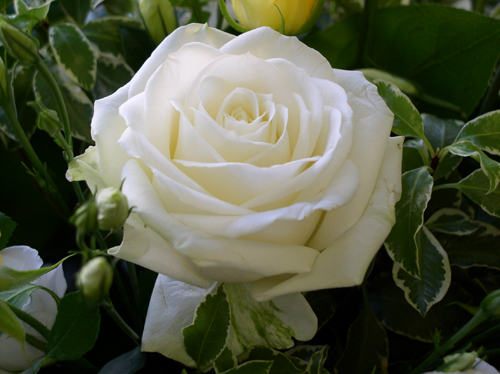
History of creation
Beauty Avalanche belongs to the exquisite hybrid tea varieties. The name translates as "avalanche". Indeed, the abundantly flowering bush resembles an avalanche that has descended from the mountains, which will cover the flower garden for a long time. Breeder Lex Voorn from the Netherlands, familiar with the intricacies of growing the queen of flowers since the age of 15, created this masterpiece in 2004. It is known in the flower market as Avalanche +. The unique codename of the rose is Lexani.
Description
The plant is not tall, neat, but power is felt in it. The bush is vertical, not too sprawling, about 80 cm high, grows up to 50 cm wide. Of course, growth rates will vary depending on growing conditions. The shoots of Avalange are strong, erect, do not lodge during flowering, and are slightly covered with thorns. One bud is formed on the stem, in very rare cases two. The foliage is good. The leaves are large, dark green, juicy, smooth, with a matte surface. They are an excellent background to highlight the delicate beauty of the rose.
The bud is dense, conical, with a slightly pointed tip and an emerald tint on the outer petals. As the dissolution proceeds, the side petals are slightly separated from the dense bud and bend to the bottom. In the half-release, the shape of the buds is classic, with a high center. In full disclosure, the shape becomes open cupped, the tips of the petals coquettishly curl back, exposing the yellow core. The diameter of the opened flower Avalange is rather big, about 8 - 10 cm. The flower consists of 17 - 25, delicate, like silk, white petals. The delicate pistachio shimmer, which can sometimes be seen at the half-release stage, only emphasizes the whiteness of the petals. The sun's rays at sunset change color, giving it a vanilla hue. According to the reviews of many rose growers, the flowers of our heroine are incomparable, and many consider her to be the standard among white roses.
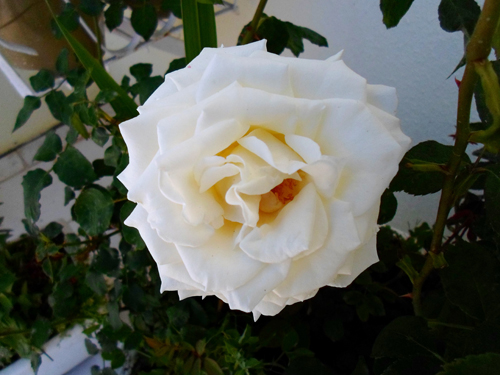
Bloom
The lovely Avalange is a multi-flowering variety. The grafted two-year-old shows excellent flowering the next year after planting. There is a short break between the first and subsequent flowering periods. True, at this moment the plant is covered with buds, albeit to an insignificant extent. The untrained eye may not be able to detect this smooth transition from the first wave of flowers to the next. Flowers in half-release do not last long, we can say that opening occurs quickly. But when fully opened, the flower keeps its shape for quite a long time. The aroma is very weak. Flowering begins in early June and lasts until the onset of cold weather.
Characteristics
- The rose has good winter hardiness. According to the USDA system, developed by the US Department of Agriculture, Avalanche winters well at temperatures of -23 ° C. In cooler regions, winter shelter is indispensable. Although according to the recall of a florist from Novosibirsk, the bush wintered well under a snow cover, without additional shelter;
- Avalange's resistance to powdery mildew and black spot is average, which, of course, is an alarming sign in unfavorable years. But according to the observations of rose growers, with a well-chosen place and correct agricultural technology, our heroine shows a high level of disease resistance.Of the pests, one should beware of bronzes, these small bugs can completely ruin the beauty of a blooming rose;
- the originators rated the rain resistance as average. Indeed, with moderate rainfall, the appearance of the beautiful snow white does not suffer too much. But during the period of torrential rains at a double flower, the petals begin to become covered with pink spots or turn black, and the buds rot without opening. This problem can be exacerbated if precipitation is accompanied by a noticeable cooling of the air;
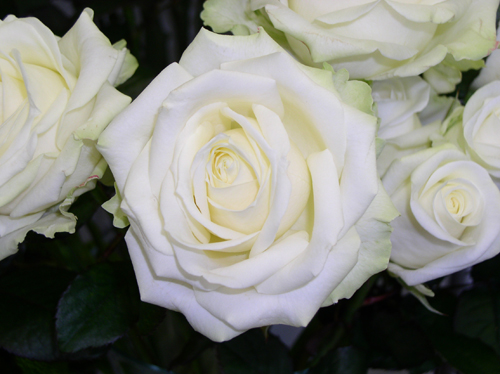
- but the plant is resistant to heat. Moreover, flower growers note that in warm weather, the flowering of Avalange can last longer than usual;
- the ability of the shrub to recover is high. The plant quickly recovers after a forced transplant (if the original planting site was unsuccessful, and the flower was constantly sick), the bush also grows well after possible freezing in winter;
- flowers do not change color throughout the entire flowering period;
- the variety is grown as a cut crop. The beautiful rose looks great in a bouquet thanks to its long, sturdy stem and elegant bud. The flower does not lose its elegant appearance in a vase within two weeks.
Planting and leaving
It is best to plant Avalange seedlings in spring. So the bush will have enough time to settle down in a new place and calmly enter a dormant period. It should be noted that, like any beauty, Avalanche is quite demanding on agricultural technology. She loves the bright sun, so the place for her planting should be as illuminated as possible. But from the wind, and especially from the draft, the plant should be covered. The acidity index of the soil should be from 5.6 to 7.3. In addition, the soil must have excellent permeability, if water stagnates in the roots, the plant can be lost. Watering should be sufficient, but before the next moistening, the soil needs to dry out a little. According to reviews, the beauty is very fond of powdery mildew, so you should not rely on relative resistance to this disease. Prevention carried out in time will relieve the plant of problems, and you - from worries about care. The variety has a very positive attitude to fertilizers, the combination of organic matter and mineral dressings for flowering will only enhance the abundance of flowering and the beauty of the flower. According to reviews of cut rose growers, our heroine feels great in greenhouse conditions.
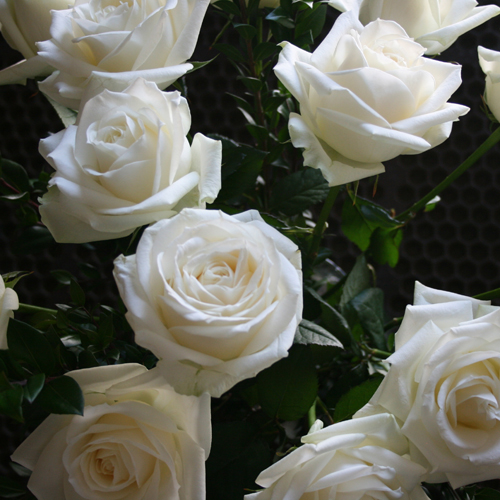
The beauty of Avalange is very fond of florists and landscape designers. The plant looks equally great in a bouquet or in a flower arrangement in a flower bed. The rose can be used in group plantings or singles. In order to show its strengths, the culture will require correct agricultural technology, but in principle, even a beginner can grow this variety. It is easy to take care of the shrub, because the thorns on the shoots are practically absent. It is still desirable to grow this rose in a warm and dry climate so that the white petals are not touched by the spotting that appears in damp weather. Reviews of the variety are mostly positive. Many rose growers successfully grow a cut plant.
Avalange has varieties that also belong to the Lex Voorn selection. These are Peach Avalanche + and Sweet Avalanche +. Both are representatives of the hybrid tea family. They differ from our heroine in color.
The first to appear was Sweet Avalanche +. Lex Wurn introduced it in 2006. The unique code is Lexteews. The variety has light pink semi-double (17 - 25 petals) flowers of a classic shape. USDA winter hardiness zone from 6 to 9.
In 2007, the Peach Avalanche + was introduced. The unique code is Lexhcaep. As the name implies, this rose has a pale apricot shade of flowers, a semi-double shape. The USDA winter hardiness zone of this Avalange variety is similar - from 6 to 9.

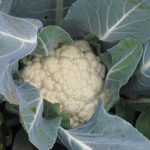
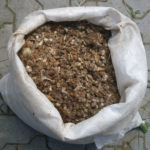
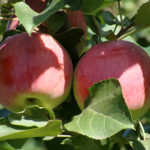





I agree that among roses with white flowers, this one is one of the best, but it turned out to have many flaws, and I refused the variety. At the beginning of the dissolution, the buds fascinate with their beauty - they are of a soft green hue (pistachio), as they dissolve, they acquire a pleasant creamy hue, and then the petals become boiling white. But, unfortunately, the process of dissolution of roses is too rapid - the buds do not hold the "glass" at all and quickly open, but, however, the opened flower lasts a long time. The variety has no winter hardiness - it often freezes out in winter, even a good shelter does not help, immunity to diseases is weak, and beetles also like to eat buds.
In a simple greenhouse, the rose feels great. I spent the winter without any problems. I have never been ill. And after planting, a two-year-old tree stump sapling from the store bloomed in the first year. And the flowers stood right up to October. The variety is unpretentious in care.